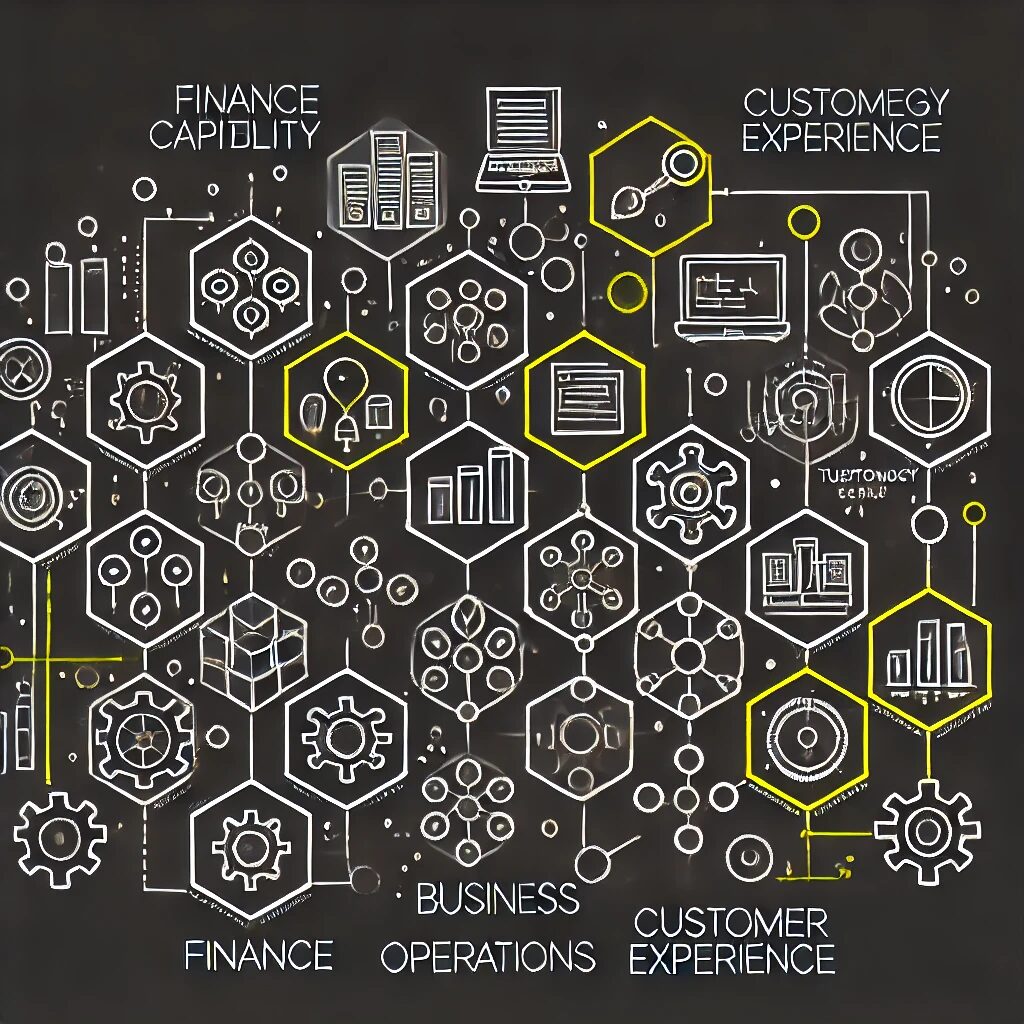
Enterprise Architecture as the Digital Transformation Cornerstone for Software Companies. From Blueprint to Breakthrough: How Enterprise Architecture Powers Software Companies’ Digital Evolution.
In today’s hyper-competitive software landscape, digital transformation has evolved from strategic option to survival imperative. Yet despite substantial investments, many software companies struggle to achieve meaningful transformation, often ending with fragmented initiatives, technical debt, and unrealized business value. The missing foundation? A robust Enterprise Architecture (EA) practice that connects strategic vision to operational reality.
For software companies navigating complex transitions—whether modernizing legacy products, pivoting to cloud-native solutions, or integrating AI capabilities—Enterprise Architecture provides the essential framework to align business strategy, technology decisions, and execution activities into a coherent transformation journey. It’s not merely about drawing diagrams; it’s about creating the structural integrity that allows your organization to evolve confidently in an era of continuous disruption.
1: Understanding Enterprise Architecture in the Software Context
Enterprise Architecture in software companies extends beyond traditional IT-centric views to encompass all facets of how the organization creates and delivers value. This comprehensive approach provides the foundation for genuine transformation rather than superficial technology change.
- Strategic Enabler: Enterprise Architecture translates business strategy into executable transformation roadmaps, ensuring technology decisions directly advance strategic objectives rather than creating expensive distractions.
- Digital Coherence Framework: EA establishes the structural framework that connects disparate transformation initiatives into a coherent whole, preventing the creation of new digital silos.
- Decision Acceleration Mechanism: A mature EA practice enables faster, more confident decision-making by providing clear principles, standards, and contextual understanding of impacts across the enterprise.
- Technical Debt Management: EA provides the objective mechanisms to identify, quantify, and systematically address technical debt that would otherwise undermine transformation efforts.
- Future-State Vision: The architecture practice develops and maintains target state architectures that guide transformation activities toward a cohesive future rather than point solutions.
2: The Architecture Domains Critical for Software Transformation
Effective digital transformation requires integration across multiple architecture domains. For software companies, these domains must work in concert to enable holistic transformation rather than departmental optimization.
- Business Architecture: This domain defines how business capabilities, value streams, and organizational structures must evolve to support new digital business models and customer experiences.
- Information Architecture: Critical for software companies, this domain addresses how data assets are structured, governed, and leveraged to create new value through analytics, AI, and embedded intelligence.
- Application Architecture: This domain focuses on modernizing application portfolios, implementing microservices, and establishing API strategies that provide the flexibility required by digital business models.
- Technology Architecture: For software firms, this domain addresses critical infrastructure decisions, including cloud migration, containerization, DevOps enablement, and security modernization.
- Security Architecture: This increasingly vital domain ensures that transformation maintains appropriate security controls while enabling the agility required by digital business models.
3: EA’s Role in Strategic Alignment for Software Companies
Digital transformation begins with clear strategic direction. Enterprise Architecture provides the critical mechanism for translating business strategy into actionable transformation plans that technology teams can execute.
- Strategy Interpretation: EA teams translate abstract strategic goals into specific capability requirements, architectural principles, and technology implications that guide implementation teams.
- Investment Alignment: Architecture governance ensures that project investments and technology decisions directly support strategic priorities rather than departmental agendas.
- Trade-off Navigation: EA provides the framework for making difficult trade-offs between speed, cost, innovation, technical debt, and risk in a manner consistent with strategic priorities.
- Digital Opportunity Identification: Mature architecture practices proactively identify how emerging technologies create new strategic possibilities, informing business strategy evolution.
- Measurement Framework Development: EA establishes how transformation progress will be measured against strategic objectives, moving beyond project milestones to business outcomes.
4: Evolving Your Technology Portfolio with EA Guidance
Software companies must continuously evolve complex technology landscapes. Enterprise Architecture provides the framework for this evolution, ensuring investments address strategic needs rather than creating new complexity.
- Application Portfolio Rationalization: EA enables objective assessment of which applications should be modernized, replaced, retired, or maintained based on strategic alignment and technical viability.
- Technical Debt Quantification: Architecture analysis provides clear visibility into where technical debt creates the greatest business risk, enabling prioritized remediation efforts.
- Cloud Migration Strategy: EA establishes a principled approach to cloud adoption that balances strategic goals, workload characteristics, data governance requirements, and operational realities.
- Integration Strategy Development: For software companies, EA defines the API and integration approaches that enable modular evolution without creating brittle dependencies.
- Platform Strategy Articulation: Architecture governance determines which technology components should be standardized as platforms versus where specialized solutions are justified.
5: Data as Strategic Asset: The EA Perspective
For software companies, data has become a primary source of competitive advantage. Enterprise Architecture ensures your data strategy delivers genuine business value rather than creating expensive data lakes with limited impact.
- Data Architecture Blueprint: EA establishes how data assets should be structured, stored, and accessed to balance innovation needs with governance requirements.
- Analytics Capability Planning: Architecture frameworks identify where and how advanced analytics and AI capabilities should be embedded within products and operations.
- Master Data Strategy: EA defines the approach for managing critical master data domains that span multiple applications and business functions.
- Data Governance Framework: Architecture governance establishes clear accountabilities for data quality, security, privacy, and lifecycle management across the organization.
- Information Value Chain Mapping: EA traces how data flows through the organization to create business value, identifying friction points and enhancement opportunities.
6: The People Dimension: EA’s Role in Culture and Organization
Digital transformation requires corresponding evolution in organizational structures, skills, and culture. Enterprise Architecture guides this people dimension to ensure alignment with technical changes.
- Organizational Impact Analysis: EA identifies how new technologies and business models require changes to roles, responsibilities, and organizational structures.
- Digital Skill Identification: Architecture frameworks reveal which new capabilities require skill development or acquisition, informing talent strategy.
- Cross-Functional Collaboration Model: EA establishes how teams from different disciplines must collaborate to deliver integrated customer experiences and business outcomes.
- Change Absorption Assessment: Architecture analysis evaluates organizational readiness for change, informing transformation sequencing and communication strategies.
- Culture Evolution Guidance: EA articulates the specific behaviors and mindsets required to succeed with new digital approaches, informing culture change initiatives.
7: Product Transformation Through Architecture Leadership
Software companies must continuously evolve their product architectures to maintain competitive advantage. Enterprise Architecture provides the framework for product evolution that maximizes business impact.
- Product Architecture Strategy: EA establishes principled approaches for evolving product architectures from monolithic to microservices, on-premises to cloud-native, or product to platform models.
- Technical Roadmap Alignment: Architecture governance ensures that product technical roadmaps align with enterprise standards while accommodating legitimate product-specific requirements.
- Common Capability Identification: EA analysis identifies opportunities to develop shared services and components that can be leveraged across multiple products, reducing duplication.
- Build vs. Buy Framework: Architecture principles guide consistent decisions about which product capabilities should be built versus sourced from partners or vendors.
- Product Infrastructure Optimization: EA provides guidance for containerization, deployment automation, and platform services that accelerate product development while reducing operational complexity.
Did You Know:
- Operational Efficiency: A study by Forrester found that software companies with effective Enterprise Architecture practices spend 40% less time on avoidable rework and integration challenges, freeing resources for innovation and strategic initiatives.
8: Agility and Innovation Through Architectural Guardrails
Enterprise Architecture is often misperceived as bureaucratic. In reality, well-designed architecture practices enable greater agility and innovation by establishing clear boundaries within which teams can operate autonomously.
- Decision Delegation Framework: EA establishes which architecture decisions should be centralized versus delegated to product teams, promoting autonomy within strategic guardrails.
- Technology Experimentation Zones: Architecture governance defines where and how emerging technologies can be safely explored without compromising enterprise stability.
- Minimum Viable Architecture: EA promotes lightweight architectural approaches that enable rapid iteration while ensuring critical non-functional requirements are addressed.
- Technical Debt Capacity Management: Architecture governance establishes guardrails for acceptable technical debt, enabling teams to make speed-versus-perfection tradeoffs appropriate to their context.
- Innovation Enablement Platforms: EA identifies shared capabilities that accelerate innovation across multiple teams, such as developer portals, API gateways, and self-service infrastructure.
9: Enterprise Architecture for Digital Ecosystems
Modern software companies operate within complex partner ecosystems. Enterprise Architecture provides the framework for effective ecosystem participation that creates strategic advantage rather than harmful dependencies.
- Ecosystem Strategy Definition: EA establishes how your organization will participate in digital ecosystems—as platform provider, specialized participant, or orchestrator—and the architectural implications.
- API Economy Enablement: Architecture frameworks define how APIs should be designed, secured, and monetized to support ecosystem participation while protecting core assets.
- Partner Integration Patterns: EA establishes standard approaches for integrating with ecosystem partners that balance speed of onboarding with security and operational considerations.
- Ecosystem Risk Management: Architecture governance identifies and mitigates risks associated with ecosystem dependencies, preventing single points of failure.
- Value Chain Positioning: EA analysis clarifies which capabilities should be provided internally versus sourced from ecosystem partners based on strategic differentiation potential.
10: Technology Radar and Emerging Tech Governance
Software companies must continuously evaluate emerging technologies. Enterprise Architecture provides the structured approach to technology evaluation that prevents chasing trends without sacrificing innovation.
- Technology Sensing Process: EA establishes systematic approaches for monitoring, evaluating, and classifying emerging technologies based on potential business impact and organizational readiness.
- Adoption Lifecycle Management: Architecture governance defines consistent phases for technology adoption—from exploration and prototyping to limited production and enterprise standardization.
- Architectural Fit Assessment: EA provides frameworks for evaluating how emerging technologies align with existing architecture principles, standards, and roadmaps.
- Risk-Balanced Innovation: Architecture analysis balances potential benefits of new technologies against integration complexities, security implications, and operational requirements.
- Capability Enhancement Mapping: EA connects emerging technologies to specific business capability improvements, ensuring adoption focuses on value creation rather than technology for its own sake.
11: Balancing Innovation and Standardization
Software companies face perpetual tension between innovation and standardization. Enterprise Architecture provides the nuanced approach that enables appropriate standardization without stifling creativity.
- Strategic Differentiation Analysis: EA identifies which capabilities truly differentiate your business and should be innovation-focused versus which are commodities better suited to standardization.
- Technology Categorization Framework: Architecture governance classifies technologies into categories with different governance approaches, from strictly standardized foundations to innovation-friendly exploration zones.
- Pattern Development: EA establishes reusable solution patterns that accelerate innovation by providing proven approaches to common challenges without mandating specific implementations.
- Variance Management Process: Architecture governance includes clear processes for requesting exceptions to standards when justified by business requirements, preventing standards from becoming innovation barriers.
- Technical Diversity Budget: EA establishes explicit limits on technological diversity to manage complexity while providing flexibility where it creates competitive advantage.
Did You Know:
- Transformation Impact: McKinsey research indicates that software companies with strong architecture governance achieve 25-30% faster time-to-market for new digital products while experiencing 20-25% lower development and maintenance costs compared to competitors with fragmented architecture approaches.
12: Modernizing Legacy for Digital Futures
Most software companies must transform legacy products and infrastructure while maintaining business continuity. Enterprise Architecture provides the framework for this complex evolution.
- Modernization Strategy Development: EA establishes principled approaches for legacy transformation—whether through refactoring, replatforming, rearchitecting, or replacement—based on business priorities and technical realities.
- Technical Debt Prioritization: Architecture analysis identifies which legacy systems create the greatest constraints on digital transformation, focusing modernization efforts where they deliver maximum business impact.
- Strangler Pattern Implementation: EA defines incremental modernization approaches that gradually replace legacy functionality without requiring “big bang” migrations that introduce excessive risk.
- Legacy-to-Modern Integration: Architecture frameworks establish how modernized components will interact with remaining legacy systems during extended transition periods.
- Bi-Modal IT Strategy: EA provides governance models that enable stable management of legacy systems alongside agile development of digital capabilities.
13: Cloud-Native Transformation Through EA Leadership
Cloud adoption for software companies extends beyond infrastructure to fundamental changes in how products are designed, built, and operated. Enterprise Architecture guides this comprehensive transformation.
- Cloud Operating Model Design: EA establishes how development, security, and operations functions must evolve to effectively build and operate cloud-native applications.
- Application Modernization Patterns: Architecture governance defines approaches for transforming applications from traditional to cloud-native designs through appropriate use of microservices, containers, and serverless architectures.
- Multi-Cloud Strategy: EA establishes principled approaches for leveraging multiple cloud providers while managing complexity and avoiding harmful provider lock-in.
- Cloud Economics Governance: Architecture analysis ensures cloud adoption delivers genuine economic benefits through appropriate service selection, resource optimization, and financial management practices.
- Cloud Security Framework: EA defines how security controls must evolve to address cloud-specific challenges while enabling the speed and agility that drive cloud adoption.
14: Establishing EA Governance for Transformation Success
Effective governance ensures architecture decisions support transformation goals without creating bureaucracy. This balanced approach maintains strategic alignment while enabling execution velocity.
- Governance Body Design: EA establishes appropriate forums, participants, and decision rights for architecture governance that balance strategic control with execution autonomy.
- Architecture Review Process: Architecture governance includes lightweight but effective review processes that identify transformation risks and alignment issues early when they’re inexpensive to address.
- Principle-Based Decision-Making: EA creates clear architecture principles that guide decision-making across the organization, reducing the need for case-by-case reviews of common situations.
- Compliance Monitoring Automation: Architecture governance leverages automated tools to verify compliance with key standards, reducing manual oversight while maintaining quality.
- Value-Focused Metrics: EA establishes governance metrics that focus on business outcomes and transformation progress rather than compliance checklists.
15: Building EA Capability for Digital Transformation
Creating effective Enterprise Architecture capability requires strategic investment in people, processes, and tools. This foundational capability enables sustained transformation rather than one-time projects.
- EA Team Evolution: Develop architecture teams that balance strategic thinking with practical implementation experience, transitioning from documentation-focused roles to transformation enablers.
- Collaborative Practices: Establish EA approaches that engage stakeholders across business, technology, and operations in co-creating architectures rather than imposing them.
- Tool Environment Optimization: Implement right-sized architecture tools that enhance collaboration and decision support without creating documentation overhead.
- EA Service Catalog Definition: Clearly articulate how the architecture function delivers value through specific services such as strategy alignment, technology evaluation, and decision support.
- Credibility Through Delivery: Build architecture credibility by demonstrating tangible contribution to transformation initiatives rather than theoretical models.
Did You Know:
- According to Gartner research, software companies with mature Enterprise Architecture practices are 2.5x more likely to successfully complete major digital transformation initiatives compared to organizations with ad hoc or project-focused architecture approaches.
Takeaway
Enterprise Architecture provides the essential foundation for successful digital transformation in software companies by connecting strategic vision to execution reality. By establishing target state architectures, guiding technology evolution, managing complexity, and ensuring business alignment, EA enables transformation that delivers genuine business value rather than just technical change. In an industry facing continuous disruption, architecture leadership differentiates companies that merely survive from those that thrive. Whether modernizing legacy products, embracing cloud-native development, or creating AI-powered solutions, Enterprise Architecture provides the structural integrity and strategic clarity essential for sustainable digital evolution.
Next Steps
- Assess Your Architecture Maturity: Evaluate your current Enterprise Architecture capability against transformation requirements to identify priority enhancement areas.
- Establish Transformation Architecture: Define the target state architecture that will enable your digital business model, focusing first on the most critical capability gaps.
- Align Governance with Agility: Create or refine architecture governance processes that maintain strategic alignment while enabling appropriate autonomy and innovation.
- Develop an Architectural Roadmap: Create a sequenced plan for evolving your technology landscape that balances strategic goals with implementation realities.
- Connect Architecture to Strategy: Ensure ongoing alignment between enterprise architecture and business strategy through structured collaboration between architecture leaders and executive teams.



